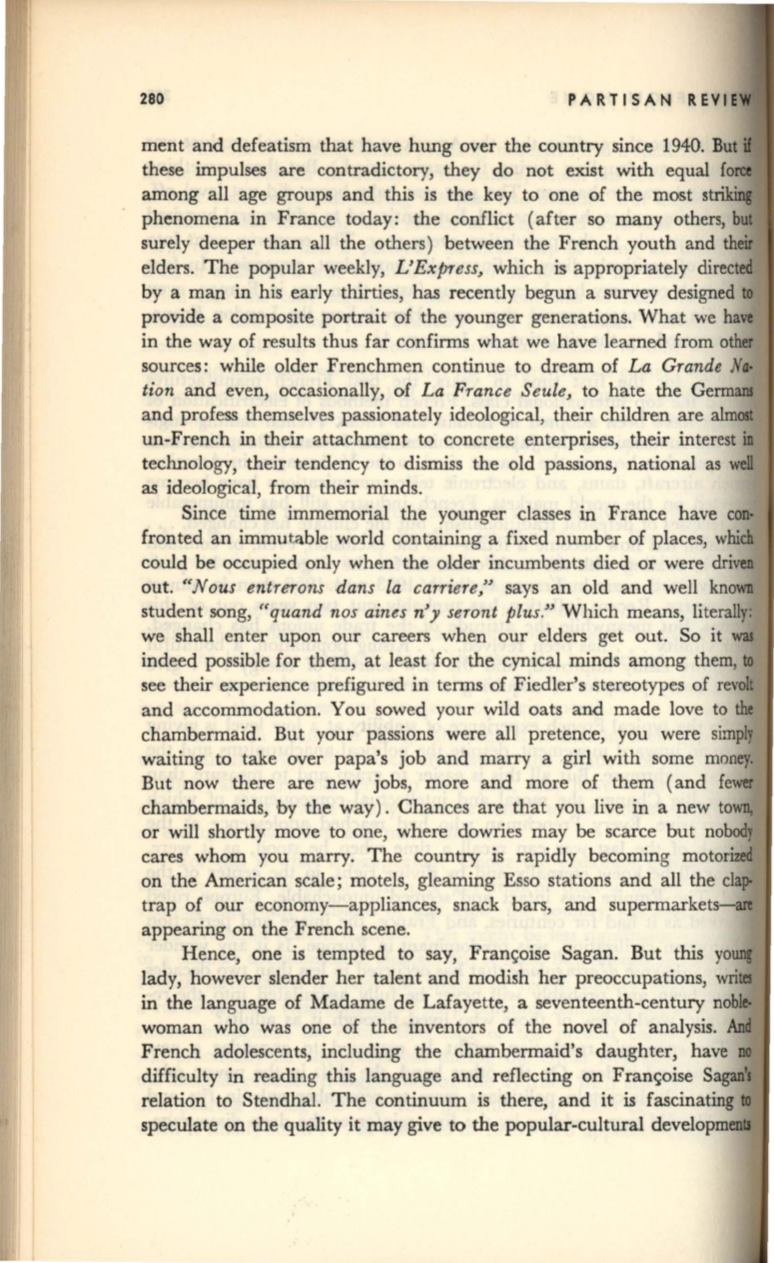
280
ment and defeatism that have hung over the country since
1940.
But
these impulses are contradictory, they do not exist with equal
among all age groups and this is the key to one of the most
phenomena in France today: the conflict (after so many others,
but
surely deeper than all the others) between the French youth and
their
elders. The popular weekly,
L'Express,
which
is
appropriately directed
by a man in his early thirties, has recently begun a survey designed
to
provide a composite portrait of the younger generations. What we have
in the way of results thus far confirms what we have learned from other
sources: while older Frenchmen continue to dream of
La Grande
N.
tion
and even, occasionally, of
La France Seule,
to hate the GermaDI
and profess themselves passionately ideological, their children are aImOit
un-French in their attachment to concrete enterprises, their interest
in
technology, their tendency to dismiss the old passions, national as
well
as ideological, from their minds.
Since time immemorial the younger classes in France have
c0n–
fronted an immutable world containing a fixed number of places,
which
could be occupied only when the older incumbents died or were driven
out.
uNous entrerons dans la carriere,"
says an old and weIl known
student song,
U
quand nos aines n'
y
seront plus."
Which means, literally:
we shaIl enter upon our careers when our elders get out. So it
was
indeed possible for them, at least for the cynical minds among them,
to
see their experience prefigured in terms of Fiedler's stereotypes of revolt
and accommodation. You sowed your wild oats and made love to
the
chambermaid. But your passions were all pretence, you were
simp~
waiting to take over papa's job and marry a girl with some money.
But now there are new jobs, more and more of them (and fewer
chambermaids, by the way). Chances are that you live in a new toWD,
or wiIl shortly move to one, where dowries may be scarce but nobody
cares whom you marry. The country is rapidly becoming motorized
on the American scale; motels, gleaming Esso stations and all the
clap–
trap of our economy-appliances, snack bars, and supermarkets-are
appearing on the French scene.
Hence, one is tempted to say,
Fran~oise
Sagan. But this yoW{
lady, however slender her talent and modish her preoccupations,
writs
in the language of Madame de Lafayette, a seventeenth-century
nob~
woman who was one of the inventors of the novel of analysis.
And
French adolescents, including the chambermaid's daughter, have
lID
difficulty in reading this language and reflecting on Franc;oise Sagan's:
relation to Stendhal. The continuum is there, and it
is
fascinating
speculate on the quality it may give to the popular-cultural
de'"elIDpln~IJ'1


